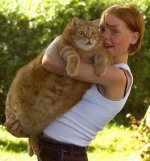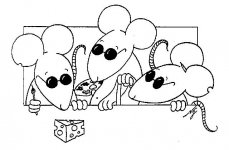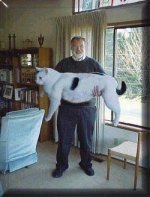Zirconium
Another scientific application for Zirconium.........
http://www.sacredgems.com/mall-healinggemstones.htm
"Cubic Zirconium has the same benefits as diamonds. They bring sun energy into the body. Wearing a CZ will energize you, especially if you wear it on your ring finger which is ruled by the sun. "
Is the use of the word "ring" close enough to fall under the ringing criteria too? I want these people to write my product information!
This is so much fun its tempting to post gratuitous pictures of pop stars and overweight cats. Somebody stop me!
Another scientific application for Zirconium.........
http://www.sacredgems.com/mall-healinggemstones.htm
"Cubic Zirconium has the same benefits as diamonds. They bring sun energy into the body. Wearing a CZ will energize you, especially if you wear it on your ring finger which is ruled by the sun. "
Is the use of the word "ring" close enough to fall under the ringing criteria too? I want these people to write my product information!
This is so much fun its tempting to post gratuitous pictures of pop stars and overweight cats. Somebody stop me!
Phonons.
Hi,
Actually you're closer than you'd expect.
Just for the fun of it:
"Phonons are quantized lattice vibrations, that is, the quantized units of the collective motions of the atomic nuclei within Ionic lattices. Since they are collective excitations with no spin, they are bosons.
Obviously, the concept of the Phonon only makes sense for solid state lattices, where the average variation of the Atomic Nuclei from their equilibrium positions, does not exceed their average interatomic distance, and their average Kinetic Energy is low, otherwise one must eventually start to consider the concept of density waves, and many other dynamic collisional and scattering processes.
Phonons come in many different forms, such as longitudinal and transverse Phonons, acoustic and optical Phonons, and may be either coherent or incoherent, and either localized or itinerant (mobile). Localized Phonons are usually referred to as Einstein Phonons.
Since the Ionic Nuclei of Atomic Lattices with itinerant Electrons are charged, Phonons are capable of interacting with Electrons and other Electromagnetic Excitations, and thus, Phonons and their Interactions are very important in the field of High Temperature Superconductivity.
Sound, Music and other acoustic vibrations, could be considered as the superposition of many different low frequency itinerant Phonons.
Heat and other thermally induced vibrational excitations, could be considered as the superposition of many different high frequency localized Phonons. "
Cheers,
Hi,
phonons (sounds like electrons/photons/ phono?)
Actually you're closer than you'd expect.
Just for the fun of it:
"Phonons are quantized lattice vibrations, that is, the quantized units of the collective motions of the atomic nuclei within Ionic lattices. Since they are collective excitations with no spin, they are bosons.
Obviously, the concept of the Phonon only makes sense for solid state lattices, where the average variation of the Atomic Nuclei from their equilibrium positions, does not exceed their average interatomic distance, and their average Kinetic Energy is low, otherwise one must eventually start to consider the concept of density waves, and many other dynamic collisional and scattering processes.
Phonons come in many different forms, such as longitudinal and transverse Phonons, acoustic and optical Phonons, and may be either coherent or incoherent, and either localized or itinerant (mobile). Localized Phonons are usually referred to as Einstein Phonons.
Since the Ionic Nuclei of Atomic Lattices with itinerant Electrons are charged, Phonons are capable of interacting with Electrons and other Electromagnetic Excitations, and thus, Phonons and their Interactions are very important in the field of High Temperature Superconductivity.
Sound, Music and other acoustic vibrations, could be considered as the superposition of many different low frequency itinerant Phonons.
Heat and other thermally induced vibrational excitations, could be considered as the superposition of many different high frequency localized Phonons. "
Cheers,
SY said:Cooper pairs???
Sheesh, Frank, some of the fumes from Amsterdam must be blowing over Belgium.
What's wrong with Cooper pairs?
They're the basis of the BCS theory of superconducitivy in Type I superconductors.
Nothing wrong with Cooper pairs per se.
What's wrong with Cooper pairs in the context of Bybee is that a) Cooper pairs only explain superconductivity in Type I superconductors, which are the pure metals. The theory doesn't quite seem to explain superconductivity in Type II superconductors which are the metal oxide ceramic types. And b) Cooper pairs don't form until you approach the superconductor's critical temperature which at present for the highest temperature superconductor available requires liquid nitrogen.
se
SUPER COOPER.
Hi,
Thanks Steve.
I remember now why I brought that up:
it was to bring to the attention the resemblance to the Cryogenic treatment .
Which was discussed around the same period here.
Cheers,
Hi,
And b) Cooper pairs don't form until you approach the superconductor's critical temperature which at present for the highest temperature superconductor available requires liquid nitrogen.
Thanks Steve.
I remember now why I brought that up:
it was to bring to the attention the resemblance to the Cryogenic treatment .
Which was discussed around the same period here.
Cheers,
Schrodingers Cat
Look what happened to my cat after I put a Bybee Quantum Purifier on the AC cord for the can opener I use to open his cat food. Oh no I think I used that can opener to open some soup the other day!
And you thought I was bluffing. Notice the subject tie in to avoid the accusation of threadjacking.
Look what happened to my cat after I put a Bybee Quantum Purifier on the AC cord for the can opener I use to open his cat food. Oh no I think I used that can opener to open some soup the other day!
And you thought I was bluffing. Notice the subject tie in to avoid the accusation of threadjacking.
Attachments
Re: Phonons.
And we have a winner for the techno babble product theory contest! As you said, Just for the fun of it.
fdegrove said:Hi,
Actually you're closer than you'd expect.
Just for the fun of it:
"Phonons are quantized lattice vibrations, that is, the quantized units of the collective motions of the atomic nuclei within Ionic lattices. Since they are collective excitations with no spin, they are bosons.
Obviously, the concept of the Phonon only makes sense for solid state lattices, where the average variation of the Atomic Nuclei from their equilibrium positions, does not exceed their average interatomic distance, and their average Kinetic Energy is low, otherwise one must eventually start to consider the concept of density waves, and many other dynamic collisional and scattering processes.
Phonons come in many different forms, such as longitudinal and transverse Phonons, acoustic and optical Phonons, and may be either coherent or incoherent, and either localized or itinerant (mobile). Localized Phonons are usually referred to as Einstein Phonons.
Since the Ionic Nuclei of Atomic Lattices with itinerant Electrons are charged, Phonons are capable of interacting with Electrons and other Electromagnetic Excitations, and thus, Phonons and their Interactions are very important in the field of High Temperature Superconductivity.
Sound, Music and other acoustic vibrations, could be considered as the superposition of many different low frequency itinerant Phonons.
Heat and other thermally induced vibrational excitations, could be considered as the superposition of many different high frequency localized Phonons. "
Cheers,
And we have a winner for the techno babble product theory contest! As you said, Just for the fun of it.
RE:Schrödinger's cat.
Hi,
For the curious:
Schrödinger's cat is a thought experiment devised by Erwin Schrödinger that attempts to illustrate the incompleteness of the theory of quantum mechanics when going from subatomic to macroscopic systems.
Said cat is placed in a sealed box. Attached to the box is an apparatus containing a radioactive nucleus and a canister of poison gas. When the nucleus decays, it emits a particle that triggers the apparatus, which opens the canister and kills the cat. According to quantum mechanics, the nucleus is described as a superposition (mixture) of "decayed nucleus" and "undecayed nucleus". However, when the box is opened the experimenter sees only a "decayed nucleus/dead cat" or a "undecayed nucleus/living cat." The question is: when does the system stop existing as a mixture of states and become one or the other? The purpose of the experiment is to illustrate that quantum mechanics is incomplete without some rules to describe when the wave function collapses and the cat becomes dead or alive instead of a mixture of both.
Who said audio can't be fun?
Hi,
For the curious:
Schrödinger's cat is a thought experiment devised by Erwin Schrödinger that attempts to illustrate the incompleteness of the theory of quantum mechanics when going from subatomic to macroscopic systems.
Said cat is placed in a sealed box. Attached to the box is an apparatus containing a radioactive nucleus and a canister of poison gas. When the nucleus decays, it emits a particle that triggers the apparatus, which opens the canister and kills the cat. According to quantum mechanics, the nucleus is described as a superposition (mixture) of "decayed nucleus" and "undecayed nucleus". However, when the box is opened the experimenter sees only a "decayed nucleus/dead cat" or a "undecayed nucleus/living cat." The question is: when does the system stop existing as a mixture of states and become one or the other? The purpose of the experiment is to illustrate that quantum mechanics is incomplete without some rules to describe when the wave function collapses and the cat becomes dead or alive instead of a mixture of both.
Who said audio can't be fun?
Steve, well, DUH! My point was, if he's got a way to generate Cooper pairs at room temperature, he shouldn't be selling hifi gizmos out of his garage, he should be picking up his million bucks from the Nobel comittee.
Frank, the cat is alive or dead the moment the detector (the trigger of the apparatus) picks up the decay. The wavefunction collapses at that moment. I don't have to watch electrons align in a magnetic field for them to do so.
Frank, the cat is alive or dead the moment the detector (the trigger of the apparatus) picks up the decay. The wavefunction collapses at that moment. I don't have to watch electrons align in a magnetic field for them to do so.
wave goodbye at this (fun)ction before I collapse
I can't even post a picture of giant cat without provoking a technical discourse. Forgive me for leaving the umlat off Schrödinger. I think I will take a break from posting till all the quantum physics dies down. You guys started early. April fools day is still two days away.
I can't even post a picture of giant cat without provoking a technical discourse. Forgive me for leaving the umlat off Schrödinger. I think I will take a break from posting till all the quantum physics dies down. You guys started early. April fools day is still two days away.
Re: SUPER COOPER.
Well, the bottom line is, unless you're using the device WHILE it's at or below it's critical temperature, Cooper pairs are wholly irrelevant.
Bybee's devices are used at room temperature.
se
fdegrove said:Thanks Steve.
I remember now why I brought that up:
it was to bring to the attention the resemblance to the Cryogenic treatment .
Which was discussed around the same period here.
Well, the bottom line is, unless you're using the device WHILE it's at or below it's critical temperature, Cooper pairs are wholly irrelevant.
Bybee's devices are used at room temperature.
se
SY said:Steve, well, DUH! My point was, if he's got a way to generate Cooper pairs at room temperature, he shouldn't be selling hifi gizmos out of his garage, he should be picking up his million bucks from the Nobel comittee.
Absolutely. Sorry if I misread your intent.
se
RE:Re: SUPER COOPER.
Hi,
Sir Steve,
Wouldn't you think I know that?
FWIW, I am not defending Bybee product.
If I get the chance to measure (if there is anything to measure) and compare the presence or absence of the product on a given system at little or no expense than that's O.K. with me.
Cheers,
Hi,
Well, the bottom line is, unless you're using the device WHILE it's at or below it's critical temperature, Cooper pairs are wholly irrelevant.
Sir Steve,
Wouldn't you think I know that?
FWIW, I am not defending Bybee product.
If I get the chance to measure (if there is anything to measure) and compare the presence or absence of the product on a given system at little or no expense than that's O.K. with me.
Cheers,
Sell?
How could I sell anything here when people fight me about the free advice I give, even when I supply links to references?
About four of those giant cats stuffed in the corners should be purrfect for breaking up room resonances. The results with triple blind mice listening test are catastrophic though.
No Charge!
How could I sell anything here when people fight me about the free advice I give, even when I supply links to references?
About four of those giant cats stuffed in the corners should be purrfect for breaking up room resonances. The results with triple blind mice listening test are catastrophic though.
No Charge!
Attachments
Fred you are really breaking me up.
The very subject about dead cats as acoustic treatment was recently discussed on the churchsoundcheck.com website. The thread was basically someone questioning the need to spend the money on an full press acoustic analysis (modeling the room in EASE and then designing the acoustic treatments accordingly) when some "dead cats" in the corners would do just as well.
As you can imagine the posters got going pretty well. Here is an example:
..... Snip ...........
I personally would like to see absorption coefficient data on a dead cat. If someone has access to a reverberation chamber I could probably
Dale Shirk
Shirk Audio & Acoustics
Terre Hill, Pa.
-----------------
At what stage do you thing you should measure the absorption coefficient?
Newly dead, 1 day, 1 week, 1 month, 1Year?
I believe it would vary!!!
I reckon I might try something with a more stable coefficient
And a lower odour coefficient too!
Not to mention I want to avoid the cat lover wars!!
But it is a fascinating image!!!
...
Phil
The very subject about dead cats as acoustic treatment was recently discussed on the churchsoundcheck.com website. The thread was basically someone questioning the need to spend the money on an full press acoustic analysis (modeling the room in EASE and then designing the acoustic treatments accordingly) when some "dead cats" in the corners would do just as well.
As you can imagine the posters got going pretty well. Here is an example:
..... Snip ...........
I personally would like to see absorption coefficient data on a dead cat. If someone has access to a reverberation chamber I could probably
Dale Shirk
Shirk Audio & Acoustics
Terre Hill, Pa.
-----------------
At what stage do you thing you should measure the absorption coefficient?
Newly dead, 1 day, 1 week, 1 month, 1Year?
I believe it would vary!!!
I reckon I might try something with a more stable coefficient
And a lower odour coefficient too!
Not to mention I want to avoid the cat lover wars!!
But it is a fascinating image!!!
...
Phil
DONKEYS.
Hi,
I much rather prefer to use dead rabbits..their ears are so much longer...
Furrily yours,
Hi,
The very subject about dead cats as acoustic treatment
I much rather prefer to use dead rabbits..their ears are so much longer...

Furrily yours,
- Status
- This old topic is closed. If you want to reopen this topic, contact a moderator using the "Report Post" button.
- Home
- General Interest
- Everything Else
- Info on Bybee Quantum Purifiers needed



